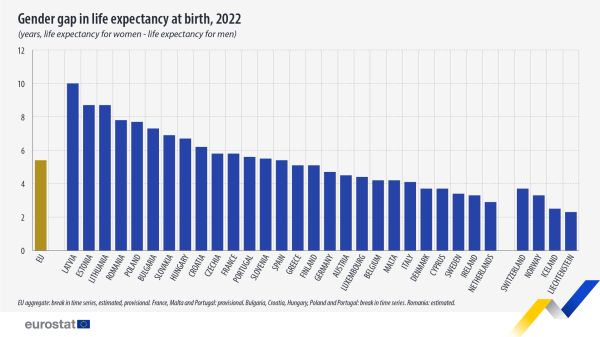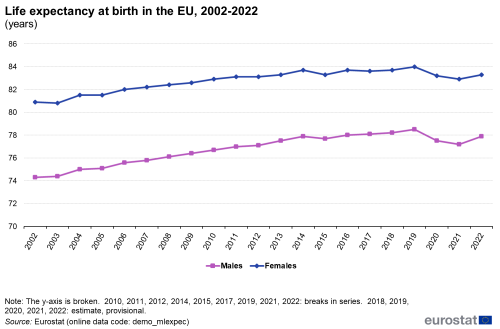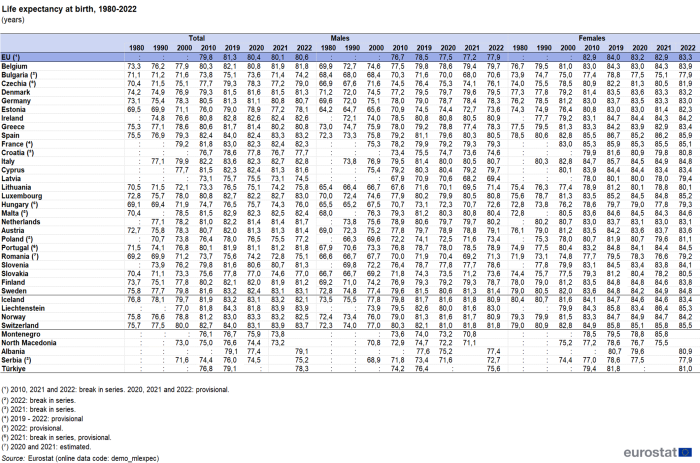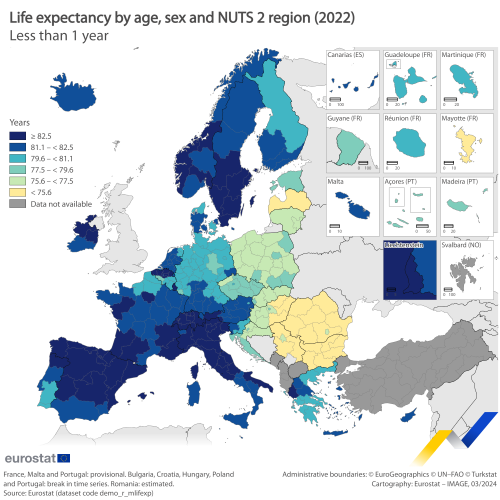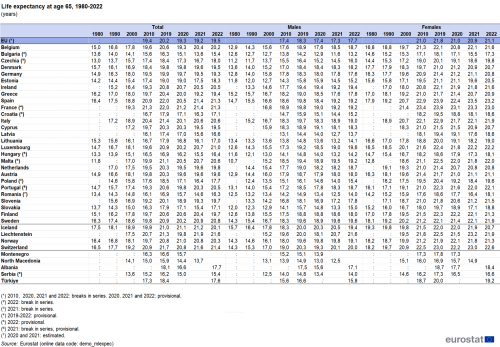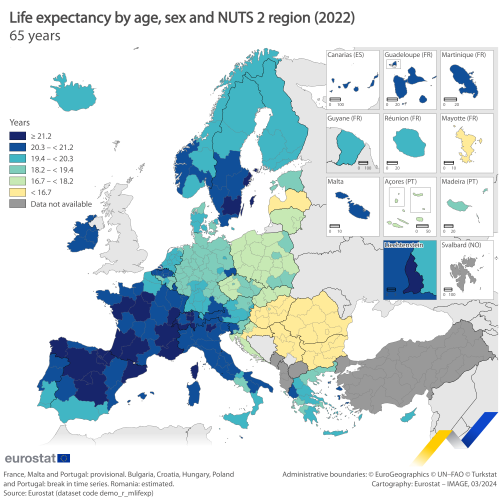Mortality and life expectancy statistics
Data extracted in March 2024
Planned article update: March 2025
Highlights
In 2022, life expectancy at birth in the EU was 80.6 years, up from 80.1 in 2021.
In 2022, the EU region with the highest life expectancy at birth was the Spanish region of Comunidad de Madrid (85.2 years).
For women, life expectancy at birth was 83.3 years in 2022, while for men it was 77.9 years.
In 2022, the gender gap in life expectancy at birth was 5.4 years in the EU with variations between EU countries.
This article provides information relating to mortality and life expectancy in the European Union (EU) based on official statistics up until 2022.
Life expectancy at birth has risen rapidly during the past century due to a number of factors. These include a reduction in infant mortality, rising living standards, improved lifestyles and better education, as well as advances in healthcare and medicine. Official statistics reveal that life expectancy has risen, on average, by more than two years per decade since the 1960s. In 2020, however, after the outbreak of the COVID-19 pandemic, this indicator declined in 25 Member States compared to 2019, the exceptions being Denmark and Cyprus. In 2021, life expectancy at birth again decreased in 16 Member States, was constant in two Member States and it increased in 9 Member States, with Belgium recording the largest increase by 1.1 years. In 2022, in many Member States the indicator increased again, however figures are still lower than in 2019 for all countries.
Full article
Number of deaths
Over the last four decades, the number of deaths in the EU oscillated between 4.18 and 4.37 million until 2011, when the number started to increase, reaching 4.69 million in 2018 and 4.65 million in 2019. Then, with the outbreak of the COVID-19 pandemic, in 2020 a total of 5.18 million of deaths was recorded in the EU, increasing to 5.30 million in 2021. In 2022, 5.15 million persons died in the EU, showing a decrease of 2.6 % in one year (see Figure 1). In the EU the crude death rate, which is the number of deaths per 1 000 persons, increased from 10.4 in 2019 to 11.6 in 2020, to 11.9 in 2021, and was estimated at 11.5 in 2022.
Life expectancy at birth
The most commonly used indicator for analysing mortality is life expectancy at birth, i.e. the mean number of years that a person can expect to live at birth if subjected to current mortality conditions throughout the rest of their life. It is a simple but powerful way of illustrating the developments in mortality.
Life expectancy at birth in the EU was estimated at 80.6 years in 2022 (0.5 years higher than in 2021), reaching 83.3 years for women (0.4 higher than in 2021) and 77.9 years for men (0.7 higher than in 2021). Overall, between 2002 (the first year for which life expectancy data became available for all EU Member States) and 2019, life expectancy at birth in the EU increased by 3.7 years, from 77.6 to 81.3 years; the increase was 3.1 years for women and 4.2 years for men. With the outbreak of the COVID-19 pandemic, life expectancy at birth in the EU decreased to 80.4 in 2020 for the entire population, i.e. a decrease of -0.9 years for the entire population, (-1 year for men from 78.5 in 2019 to 77.5 in 2020 and -0.8 years for women from 84 in 2019 to 83.2 in 2020). Life expectancy at birth further decreased in 2021 to 80.1 for the entire population, 77.2 years for men and 82.9 for women. In 2022, for the first time since the outbreak of the COVID-19 pandemic, an increase in life expectancy at birth can be observed in the EU to 80.6 years for the total population, 77.9 years for men and 83.3 years for women. However figures are still lower in 2022 compared with 2019.
In 2020, after the outbreak of the COVID-19 pandemic, life expectancy at birth declined in 25 Member States compared to 2019, the exceptions being Denmark and Cyprus. In 2021, life expectancy at birth again decreased by 1 year or more in 11 Member States (Bulgaria, Czechia, Estonia, Greece, Croatia, Cyprus, Latvia, Hungary, Poland, Romania and Slovakia), it decreased by less than 1 year in 5 Member States (Denmark, Germany, Ireland, Lithuania and Finland), it was unchanged in two Member States (Austria and Netherlands) and it increased in the other 9 Member States, with Belgium recording the largest increase by 1.1 years.
In 2022, in 19 Member States there was a significant increase in life expectancy (see Table 1 and Table 2) compared with 2021. The largest increases of total life expectancy at birth (males and females) were recorded in Bulgaria (+2.8 years), Slovakia (+ 2.4 years) and Romania (+2.3 years) compared with 2021. However, figures are still lower than in 2019 for all countries. The indicator decreased in seven EU countries with Finland experiencing the biggest drop at -0.7 years in 2022. Sweden was the only country showing no change compared to 2021.
As shown in Table 1, in 2022, life expectancy at birth decreased in three of the EFTA countries, whereas in Liechtenstein it remained unchanged compared to the previous year. From the time series it can be seen that since the year 2000 life expectancy at birth increased between 2.4 years in Iceland and 6.9 years in Liechtenstein. During the same period life expectancy at birth for women increased by 1.8 years in Iceland, by 2.7 years in Norway and Switzerland and by 5.4 years in Liechtenstein. For men, there was also an increase which ranged from 3.1 years in Iceland to 9.1 years in Liechtenstein.
Across the EU regions, in 2022, the highest life expectancy at birth was in the Comunidad de Madrid (85.2), followed by Provincia Autonoma di Trento in Italy (84.4) and Ile de France (84.1). The EU regions with the lowest life expectancy at birth were in Bulgaria: Severozapaden (72.3), Severen tsentralen (73.2) and Yugoiztochen (73.7).
Compared with 2021, Yugozapaden in Bulgaria recorded the highest increase in life expectancy at birth (+3.0 years), followed by Severoiztochen (also in Bulgaria) (+2.9 years). On the other side, the highest decrease in life expectancy at births between 2021 and 2022 could be observed in the Finnish region of Åland (-1.5 years) and Região Autónoma dos Açores in Portugal (-1.2 years).
Life expectancy at age 65
As can be seen in Table 2, life expectancy at age 65 in the EU increased slightly in 2022 by 0.3 years compared with 2021. In 2022, life expectancy at 65 was estimated at 19.5 years, being 21.1 years for women (0.2 years higher than in 2021) and 17.7 years for men (0.4 years higher than in 2021). In 2022, life expectancy at age 65 decreased in 8 EU Member States whereas it increased in 15 Member States, for both men and women (see Table 2). The highest life expectancy at 65 in 2022 could be observed in France and Spain (21.3 years) and the lowest in Bulgaria (15.4 years). For women, the highest life expectancy at age 65 in 2022 was in Spain (23.2 years) and the lowest in Bulgaria (17.3 years) while for men the highest was in Sweden and Luxembourg (both at 19.6 years) and the lowest was in Bulgaria (13.2 years). The highest increase in life expectancy at age 65 between 2021 and 2022 could be observed in Bulgaria (+1.8 years for women and +1.6 year for men) while the largest decrease was recorded in Finland (-0.8 years for women and -0.6 years for men).
In 2022, all EFTA countries experienced a decrease in life expectancy at age 65, with Iceland showing the biggest decrease (-1.1 years). In 2022, life expectancy of men aged 65 ranged from 19.1 years in Norway to 21.6 years in Liechtenstein, while the life expectancy for women aged 65 varied from 20.7 years in Iceland to 22.6 years in Switzerland. The time series shows that between 2000 and 2022 overall life expectancy at age 65 increased between 1.2 years in Iceland and 4.1 years in Liechtenstein. During the same period, female life expectancy at age 65 increased between 0.9 years in Iceland and 2.4 years in Liechtenstein while Norway and Switzerland saw an upwards trend of 1.4 and 1.7 years, respectively. As regards men, their life expectancy at age 65 climbed by 1.6 years in Iceland, 3.0 years in Norway and Switzerland and 6.4 years in Liechtenstein.
Looking at the EU regions, in 2022, the regions Comunidad de Madrid in Spain recorded the highest life expectancy at age 65 (22.9 years).
Gender gap in life expectancy
There are still major differences between countries when looking at the life expectancy of men and women. In 2022, life expectancy for women was still higher than life expectancy for men as in previous years. With a gender gap of 5.4 years in 2022, newly born girls in the EU could generally expect to outlive boys. Furthermore, this gender gap in life expectancy varied substantially between EU Member States. In 2022, the largest difference between the sexes was found in Latvia (10.0 years) and the smallest in the Netherlands (2.9 years). In 13 Member States this gender gap in life expectancy was above the EU average — see Figure 3. Compared with 2021, the gender gap narrowed in the EU in 2022 (from 5.7 years in 2021 to 5.4 in 2022), as well as in 19 Member States.

Source: Eurostat (demo_mlexpec)
In 2022, as in previous years, EFTA countries recorded gender-related life expectancy differences below the EU average (5.4 years), ranging from 3.7 years in Switzerland to 2.3 in Liechtenstein. As regards gender differences, life expectancy at birth for women dropped in all EFTA countries in 2022 when compared to 2021, ranging from -0.3 years in Switzerland to -1.2 years in Iceland. By contrast, for men it fell in two countries, namely Iceland and Norway (-0.9 and -0.8 years, respectively) while in Liechtenstein it increased by 1.4 years. For Switzerland, no change was observed.
When looking at life expectancy at age 65, it can be seen that the gap between the sexes is smaller than the gap at birth. In 2022, women aged 65 in the EU could generally expect to outlive men by 3.4 years. The largest difference between the sexes in 2022 was found in Estonia (5.3 years) and the smallest in the Netherlands (2.1) — see Figure 4.
Figure 4 shows that in 2022 women aged 65 in EFTA countries could expect to outlive men by a minimum of 0.3 years in Liechtenstein to a maximum of 2.6 years in Switzerland. Looking at gender differences one observes that female life expectancy at age 65 dropped in all EFTA countries, ranging from -0.4 years in Switzerland to -1.3 years in Liechtenstein. On the other hand, for life expectancy for males at age 65 fell in 3 EFTA countries, namely Switzerland (-0.1), Norway (-0.7) and Iceland (-1.1 years), while it increased in Liechtenstein (+0.9 years).
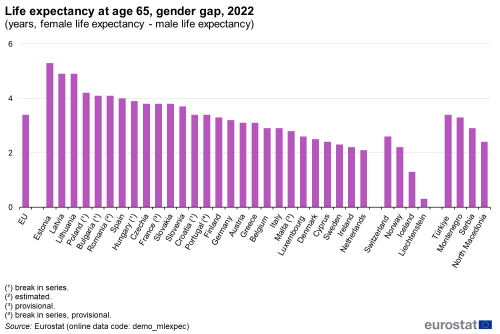
(years, female life expectancy - male life expectancy)
Source: Eurostat (demo_mlexpec)
Infant mortality
Around 12 872 children died before reaching one year of age in the EU in 2022 (208 fewer than in the previous year); this was equivalent to an infant mortality rate of 3.3 deaths per 1 000 live births. Compared with 2019, the last year before COVID-19, the infant death toll dropped by 1227 in 2022.
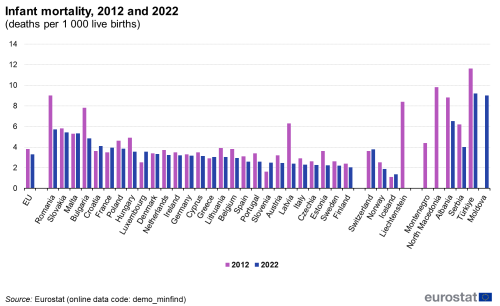
(deaths per 1 000 live births)
Source: Eurostat (demo_minfind)
One of the reasons for the increase in life expectancy at birth in the EU has been the decrease in infant mortality rates. Between 2012 and 2022, the infant mortality rate in the EU fell from 3.8 deaths per 1 000 live births to 3.3 deaths per 1 000 live births. When extending the analysis to the last 20 years or so, the infant mortality rate has almost halved (6.2 deaths per 1 000 in 1999). The most significant reductions in infant mortality were generally recorded within those EU Member States that tended to record higher levels of infant mortality in earlier years when compared with the EU average. Overall, the decrease in infant mortality rates was one of the factors contributing to higher life expectancies at birth over the same period.
In 2022, the highest infant mortality rates in the EU were registered in Romania (5.7 deaths per 1 000 live births) and Slovakia (5.4 deaths per 1 000 live births), and the lowest was recorded in Finland (2.0 deaths per 1 000 live births).
In EFTA countries, infant mortality rates ranged from 0.0 deaths per 1 000 live births in Liechtenstein to 3.8 deaths per 1 000 live births in Switzerland.
Source data for tables and graphs
Data sources
Eurostat provides information on a wide range of demographic data, including statistics on the number of deaths by sex, by age, by year of birth, as well as according to citizenship, country of birth and educational attainment; statistics are also collected for infant mortality and late foetal deaths. A series of mortality indicators are produced, which can be used to derive a range of information on subjects such as crude death rates or life expectancy measures by age, sex or educational attainment.
Context
In the last twenty years, the gradual increase in life expectancy in the EU has been one of the main factors contributing to the ageing of the EU population — alongside relatively low levels of fertility that have persisted for decades (see the articles on population structure and ageing and fertility statistics).
The outbreak of the COVID-19 pandemic, in 2020, will have a lasting impact on the way we live and work together. The outbreak came at a time when Europe had already been going through a period of profound demographic and societal change. On 17 January 2023, the European Commission published the Staff Working Document on The impact of demographic change in a changing environment that provides further analysis of the demographic consequences of the COVID-19 pandemic. More information of the work of the European Commission 2019-2024 to tackle the impact of demographic change in Europe can be found in the European Commission dedicated pages.
Direct access to
- Demography of Europe - 2023 edition
- Key figures on the EU in the world - 2023 edition
- The impact of demographic change in a changing environment
- The life of women and men in Europe - 2022 interactive edition
- Regions in Europe - 2023 edition
- Ageing Europe - 2021 interactive edition
- 2020 Report on the impact of demographic change
- Mortality (national level) (t_demo_mor)
- Life expectancy at birth by sex (tps00205)
- Life expectancy at age 65, by sex (tps00026)
- Infant mortality rate (tps00027)
- Deaths and crude death rate (tps00029)
- Mortality (regional level) (t_demo_mor)
- Deaths by NUTS 2 region (tgs00098)
- Life expectancy at birth by sex and NUTS 2 region (tgs00101)
- Infant mortality rate (tps00027)
- Mortality (ESMS metadata file - demo_mor_esms)
- Population (ESMS metadata file — demo_pop_esms)
